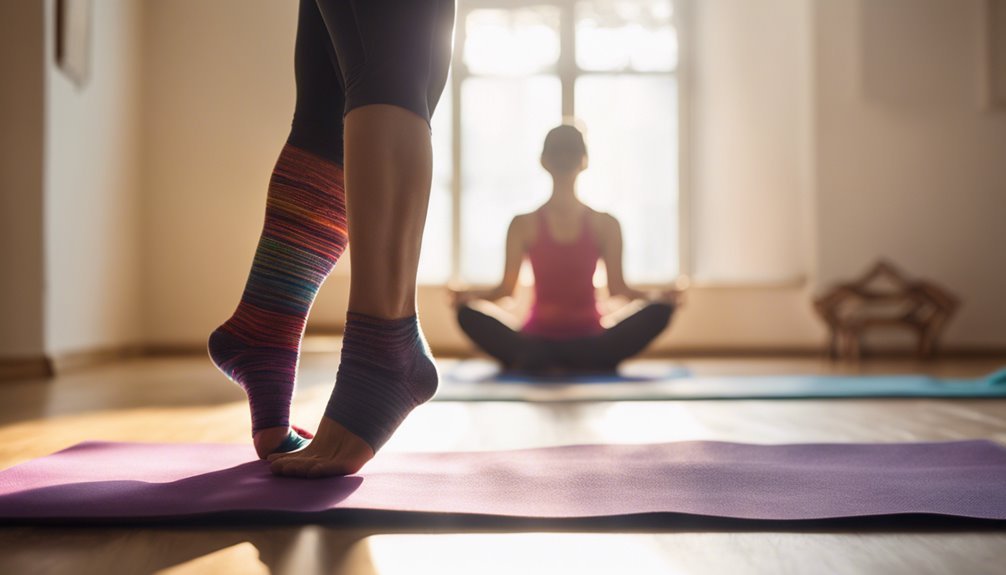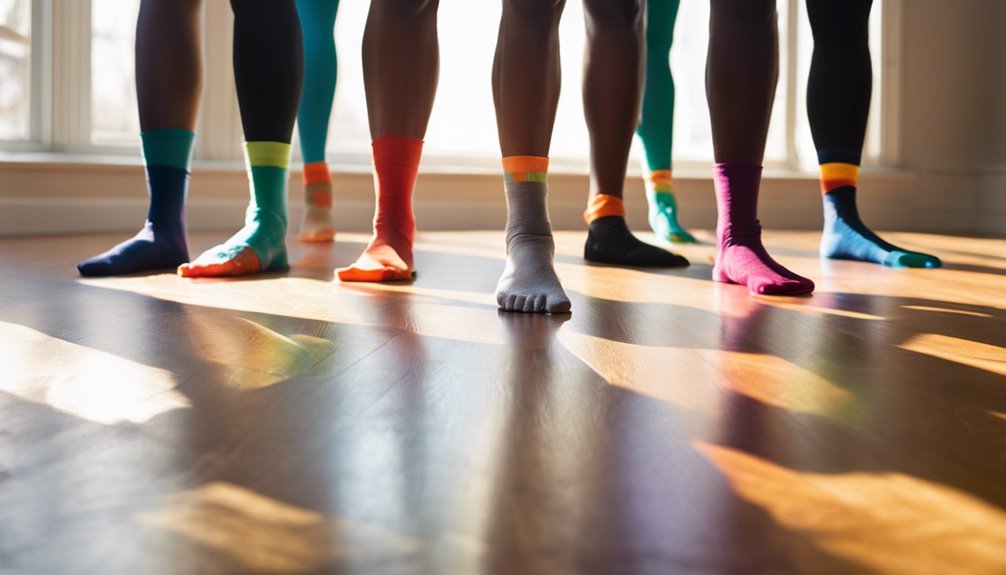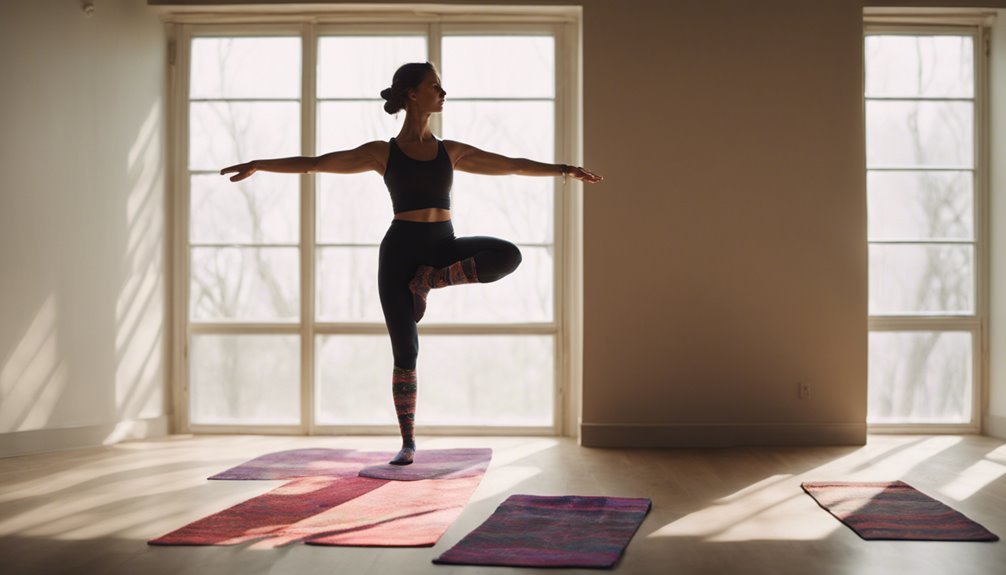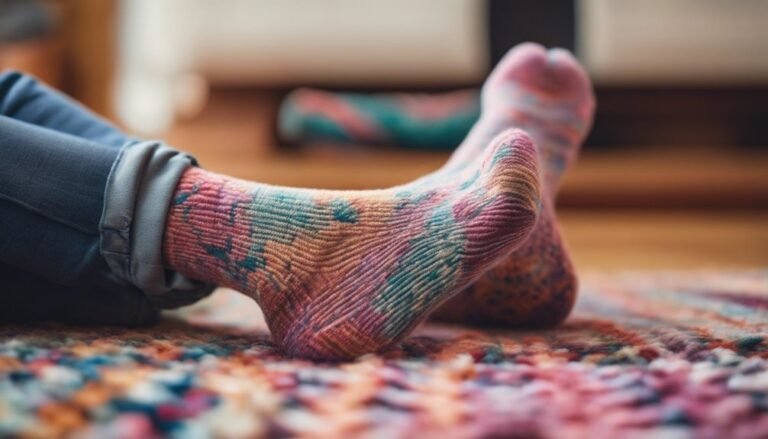Can Socks Improve Posture? Exploring the Connection
Imagine this: You're walking down a bustling city street, feeling a slight discomfort in your back. You pause to adjust your posture, wishing there was an easy fix.
Have you ever noticed how something as simple as the socks you wear might make a difference? Surprisingly, while socks can't replace traditional posture correction, they can enhance foot alignment and distribute weight more evenly, which supports your posture.
Featuring arch support and targeted compression, these scientifically designed socks use materials like nylon and spandex to improve circulation and proprioception.
While they offer a non-invasive option, their effectiveness varies and should complement existing strategies. By learning more, you'll discover how these socks align with your postural needs.
Understanding Posture and Its Importance

While posture might seem like a simple concept, it's actually a complex interplay of bones, muscles, and nerves that guarantees your body maintains balance and alignment. Understanding posture fundamentals is important for sustaining musculoskeletal health and preventing discomfort. Proper posture makes certain that your body's weight is evenly distributed, minimizing strain on supporting structures.
For those seeking freedom from chronic pain or movement limitations, posture correction becomes necessary. Evidence-based strategies, like ergonomic adjustments and targeted exercises, can enhance your postural alignment. With consistent practice, these interventions can help optimize your body mechanics, promoting independence and liveliness.
The Anatomy of Posture-Enhancing Socks
When considering posture-enhancing socks, it's important to focus on specific design features such as arch support and targeted cushioning, which can greatly improve alignment and reduce discomfort. The materials used, often incorporating moisture-wicking and breathable fabrics, play an essential role in maintaining foot health and preventing irritation. Compression zones within these socks are designed to enhance circulation, contributing to improved posture by providing stability and support to the lower extremities.
Sock Design Features
Posture-enhancing socks are more than just foot coverings; they're meticulously designed tools aimed at improving your overall stance and alignment. By incorporating design innovations, these socks offer ergonomic features that provide targeted support where it's needed most. You might find arch support structures that promote ideal foot positioning, ensuring proper weight distribution and reducing strain on your musculoskeletal system. Additionally, heel and toe reinforcements are crafted to enhance stability, aiding in the correction of postural imbalances.
These socks often feature strategically placed cushioning, which can alleviate pressure points and improve proprioception—your body's awareness in space. Such enhancements allow you the freedom to move with confidence and ease, fostering an environment where your skeletal and muscular systems can function harmoniously, promoting long-term postural health.
Material and Compression
To understand the effectiveness of posture-enhancing socks, it is important to examine their material composition and compression technology. Material types play a significant role, as they must offer durability, breathability, and elasticity. Synthetic fibers like nylon and spandex commonly provide these attributes, promoting comfort and posture support. Compression benefits include improved circulation and reduced muscle fatigue, essential for maintaining proper alignment. By applying graduated pressure, these socks enhance proprioception—your body's awareness of position and movement. This can lead to subtle posture adjustments, fostering freedom in your daily activities. Selecting the correct compression level is crucial, as excessive pressure may impede circulation. Consequently, posture-enhancing socks blend innovative materials and compression techniques to subtly influence posture without restricting your freedom.
Scientific Insights Into Sock-Induced Postural Changes

You'll find that recent studies have highlighted how sock material can considerably influence postural stability by affecting foot alignment and pressure distribution. Evidence suggests that socks with integrated arch support mechanisms can enhance proprioceptive feedback, potentially improving balance and reducing musculoskeletal strain. Understanding these interactions empowers you to make informed choices for optimizing posture and minimizing discomfort.
Sock Material Impact Studies
Although often overlooked, the material composition of socks can greatly influence one's posture. Studies suggest that sock fibers play a pivotal role in maintaining ideal foot alignment by facilitating effective moisture management. When your feet are dry, you're less likely to experience slippage or discomfort, which can lead to compensatory postural adjustments.
Synthetic fibers like polyester and nylon offer superior moisture-wicking properties, reducing the risk of fungal infections and skin irritation. However, natural fibers such as cotton, while breathable, can retain moisture, potentially compromising foot stability.
Arch Support Mechanisms
A significant aspect of sock design is its ability to provide arch support, which can profoundly affect posture. By catering to different arch types, socks can enhance foot alignment, offering a stable foundation. Scientific evidence suggests that proper support in socks promotes ideal distribution of body weight, potentially alleviating strain on the musculoskeletal system. For individuals with flat or high arches, specific sock designs can help in maintaining correct foot positioning.
Benefits and Limitations of Posture-Improving Socks
While the concept of posture-improving socks may seem innovative, it's vital to weigh their benefits and limitations to make an informed decision. These socks often claim to enhance postural alignment, yet the effectiveness debate persists among healthcare professionals. Some studies suggest minor improvements in posture-related discomforts, offering a non-invasive option for those seeking greater freedom from traditional corrective aids. However, comfort considerations are paramount; not all individuals may find them suitable for prolonged use due to varying designs and materials.
Moreover, these socks should not replace thorough postural correction methods such as physical therapy or ergonomic adjustments. They can be a supplementary tool, but it's important to consult with a healthcare provider to determine their appropriateness for your specific needs. Balancing innovation with practicality guarantees ideal outcomes.
Real-Life Experiences: Testimonials and Case Studies

Numerous individuals have shared their experiences with posture-improving socks, offering valuable insights into their practical effects. User testimonials reveal that many have witnessed a reduction in musculoskeletal discomfort and improved spinal alignment. For instance, one user reported enhanced proprioception, leading to a noticeable decrease in back pain, allowing more freedom in movement. Case studies support these claims, illustrating positive outcomes in ergonomic posture and balance stabilization.
In exploring user experiences, it becomes evident that these socks can facilitate proprioceptive feedback, promoting postural correction and gait improvement. Users often emphasize the enhanced sense of balance and support that these socks provide, highlighting their significance in daily activities. While individual results vary, the overwhelming majority underscore a promising adjunctive role in posture management.
Choosing the Right Socks for Your Postural Needs
Selecting the right socks for your postural needs is essential in ensuring effective support and alignment. When considering sock thickness, remember that a thicker sock can offer additional cushioning and shock absorption, potentially benefiting foot alignment. Conversely, thinner socks might provide better proprioceptive feedback, aiding in precise postural adjustments. Your choice should reflect your unique biomechanical needs and lifestyle freedom.
| Sock Type | Sock Thickness | Foot Alignment Benefit |
|---|---|---|
| Compression | Medium | Enhances circulation, reduces fatigue |
| Padded | Thick | Cushions impact, supports arches |
| Minimalist | Thin | Promotes natural foot movement |
| Orthopedic | Variable | Customizable for precise alignment |
| Athletic | Variable | Balances support and flexibility |
Incorporate evidence-based practices and consult a healthcare professional if needed, ensuring your sock choice aligns with your postural goals.
Frequently Asked Questions
Do Posture-Improving Socks Need to Be Worn All Day?
About 80% of adults experience back pain at some point. You don't need to wear posture-improving socks all day. Their sock design promotes posture awareness, so integrating them when seated or standing might be enough for noticeable benefits.
Can Children Benefit From Wearing Posture-Enhancing Socks?
You might wonder if children's posture benefits from these socks. Evidence suggests they can support alignment, enhancing spinal health. While not a sole solution, they're a non-restrictive aid that offers potential posture improvement for active, growing kids.
Are There Specific Exercises to Complement the Use of These Socks?
Imagine Jane, a busy professional, who integrates socks exercises and alignment stretches into her daily routine. You'd notice improvements in her posture. Evidence suggests combining these socks with exercises enhances spinal alignment and promotes long-term freedom from discomfort.
How Do Posture-Enhancing Socks Compare to Orthotic Insoles?
You're curious about the comparison: Posture-enhancing socks with advanced socks technology aim for better foot alignment, offering flexibility. Meanwhile, orthotic insoles are evidence-based for structural support. Your choice depends on desired freedom versus medical-grade support. Choose wisely.
What Materials Are Commonly Used in Posture-Improving Socks?
You're likely curious about the materials in posture-improving socks. They often use compression materials like spandex and nylon, alongside breathable fabric types such as cotton or bamboo, ensuring comfort while promoting alignment and offering freedom of movement.







